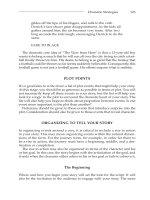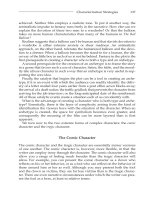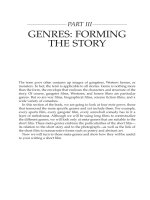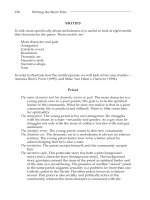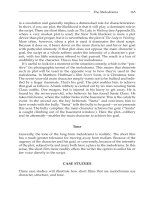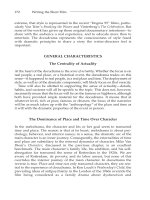Tài liệu Writing the short film 3th - Part 30 doc
Bạn đang xem bản rút gọn của tài liệu. Xem và tải ngay bản đầy đủ của tài liệu tại đây (152.13 KB, 7 trang )
of World War II, with his parents dead and the fate of Danzig decided (it is
captured by the Russians and becomes part of Soviet-occupied Poland).
Now 20, Oscar begins to grow again. The goal is made more plausible by
giving Oscar other eccentricities and characteristics. For instance, he always
carries his drum. The drum, and his scream, which shatters glass, are the two
means Oscar chooses to use to communicate his feelings.
The Antagonist
There is no single antagonist in The Tin Drum. If there is any force that
plays this role it would be nationalism, specifically the Nazi form, which in
its aggressiveness destroyed countless people, relationships, and commu-
nities. The focus in The Tin Drum is on one family, on its destruction in the
period when its progeny, Oscar, chose stunted growth as a defense against
Nazism.
Oscar is not a political character, and his story unfolds in a reactive, emo-
tional, and visceral fashion. Consequently, the antagonist—nationalism—
manifests itself only in the relationships within Oscar’s family and in the fate
of those who have been kind to him—a Jew, a female Italian dwarf—and of
course in the fate of the three people who he considers to be his parents. In
this sense the antagonist is an atmosphere, a distant political entity, rather
than a single person.
The Catalytic Event
Oscar’s birth is the catalytic event of the narrative. In the birth canal, he
appears already fully formed, with knowing eyes, the same size he will be
when he makes his fateful decision to stop growing. He is thus presented at
birth with a sense of seeing and knowing that one does not associate with a
newborn child. This presentation makes credible the act of will that marks
the end of his growth. It also positions Oscar as the perennial observer rather
than participant in the events that shape his life. Also, because he is pre-
sented as a passive observer—in essence the position of the child in society—
we observe events as he does, with an unusual detachment given the nature
of the events that will follow.
The Resolution
The war ends. His German father chokes on his Nazi Party pin while try-
ing to hide it from a Russian. At the burial, Oscar consciously decides
that he will resume physical growth. His stepbrother throws a stone,
which strikes him. He falls on his father’s grave, and he begins to grow
once more.
The Hyperdrama 193
Ch15.qxd 9/27/04 6:11 PM Page 193
The Dramatic Arc
The journey that Oscar travels spans the 20-year history following World
War I. It is a political history wherein Danzig is made a free state, neither
German nor Polish. It is an uneasy state, because each minority identifies
with its ethnic parent, whether it be Germany or Poland. As events shift and
German nationalism becomes a force, brownshirts and swastikas begin to
proliferate, and brutality toward Jews grows. War comes on September 1,
1939; the battle for the post office becomes the microcosm for German
aggression and Polish resistance. The town is quickly occupied. The
Germanization of Danzig is rapid, and the rise and fall of German fortunes
of war chronicle the history of the town. Finally, the Russians overrun the
city, and the war is over. This is the plot of The Tin Drum.
The background story is the chronicle of Oscar’s relationships with his
grandmother, his mother, the two fathers, a housekeeper, and finally a
troupe of midgets and dwarfs. Only among the dwarfs does Oscar have any-
thing approximating a peer, an adult relationship. In all other cases, he is the
child reacting against the cruelty and unsettling qualities of the adult world.
The relationships never progress very far; they are always inhibited or ended
by the progress of the plot.
The Narrative Style
The Tin Drum has a great deal of plot, as one would expect in a hyperdrama.
But it also has many character scenes. The character layer, however, is never
developmental. Oscar is principally the child, and the adults seem transient
in his world; they exit, or they die. Only the grandmother provides any con-
tinuity for Oscar.
The Narrative Shape
Time is not a critical factor in this story. Because the character is resistant to
the passage of time (he stops his own physical growth), physical time is in
fact suspended as an element in his life. The story itself follows 45 years of
the history of one family in this Baltic region.
Tone
“Fantastic” is the first observation one makes about the tone of this film.
Events are extreme. A woman hides a man from the police beneath her
expansive four skirts. While she is being questioned by the police in the mid-
dle of a potato field, he impregnates her. Later a birth canal is observed by
the child who is to be born. Three years later, the main character decides to
grow no longer. All these events are fantastic, beyond belief, and yet together
they set the moral parameters of this story.
194 Writing the Short Film
Ch15.qxd 9/27/04 6:11 PM Page 194
Later the fantastic is joined by the macabre. Oscar’s parents observe
eels being caught in the sea. A dead horse’s head yields the fresh eels that
will be dinner. The wife is revolted, and yet later she kills herself by
overeating fish. Even later, the father is killed by choking on his Nazi
Party pin—he had tried to hide it from a Russian by swallowing it. All
these events are symbols of the relationship of life to death in the period
of the Third Reich. In the end, all the death symbols—the swastika, the
bodies of men and animals—prove to be toxic. They kill all of Oscar’s
parents.
Seconds
The Main Character and His Goal
The main character in the film Seconds is Arthur Hamilton, a 55-year-old
banker who no longer finds meaning in his life. Although married, father of
a married daughter and a bank vice president, Arthur Hamilton has no
enthusiasm for life. As he says about his wife, “We get along.” That state-
ment captures his sense of his life. His goal is to change, to be “reborn.”
The Antagonist
The company that promises to recreate Arthur Hamilton and to totally alter
his life is the antagonist. Although it undertakes extensive plastic surgery
and physically relocates him from Westchester to Malibu, the company in
fact completely controls his life.
The Catalytic Event
Arthur receives a call from an old friend, who has himself been reborn. This
contact begins the process of Arthur’s rebirth.
The Resolution
Arthur decides he wants to go back to his old life and so informs the com-
pany. Furthermore, he will not cooperate with them to find a replacement for
himself. The company destroys Arthur, now called Tony Wilson, using his
body to help another reborn client.
The Dramatic Arc
The journey that Arthur Hamilton, 55-year-old banker, will take is to be
transformed into a 35-year-old artist, Tony Wilson (Rock Hudson), living in
Malibu. Much effort is put into acclimatizing Arthur/Tony to his new life.
The Hyperdrama 195
Ch15.qxd 9/27/04 6:11 PM Page 195
Many company employees and other “reborns” participate. When
Arthur/Tony finally feels comfortable in his new life (he has the love of a
woman, a relationship), a drunken indiscretion about who he really is breaks
the facade. His lover in fact is an employee of the company. His neighbors
are all linked to the company. Totally disillusioned, Arthur/Tony returns to
Westchester. There he visits his wife under the pretext of securing one of her
husband’s paintings. There he discovers what his wife thought of her hus-
band—that he had been dead long before he was the victim of a hotel fire
(the ruse to cover his transformation from Arthur Hamilton to Tony Wilson).
Now he understands—it was not his age; it was his attitude toward life. He
wants to go back. He is returned to the company in New York, but he is non-
cooperative. He does not know it, but his fate is sealed—he no longer has
any value for the company. It kills him.
The Narrative Style
Seconds is plot-driven, focusing on Arthur Hamilton’s transformation into
Tony Wilson and then his desire to become Arthur Hamilton again.
Throughout, he is a victim of his own alienation and his unhappiness. When
he wakes up, it’s too late.
The character layer of this story is principally the failed relationship with
his wife and the developed relationship with a younger woman in Malibu.
Only later does he discover she is an employee of the company. The two
male relationships that are explored are with his college friend Charlie, the
reborn who brings him to the company, and with the paternalistic head of
the company. In both cases, Arthur is naive enough to believe what they say.
The character layer throughout demonstrates Arthur’s poor judgment. He
keeps making bad choices. Only his wife seems genuine, strong, and
nonmanipulative—and he walks away from that relationship in order to be
reborn.
Together these two layers portray how alienation can promote poor judg-
ment, and in the end, self-destruction.
Tone
The tone of Seconds is extreme. Both the urban and rural settings focus on
isolation and separateness. Also there is paranoia. Arthur is pursued in
Grand Central Station by a faceless man. When he first visits the company,
he finds himself in a slaughterhouse. Critical moments are ritualized—
the operation, the grape-crushing sequence in Santa Barbara where
Arthur/Tony loses his inhibitions, the drunken scene at his home in Malibu.
All these scenes are rituals, meant to mark Arthur/Tony’s rites of passage.
Key in both environments (his past life setting and his new life setting), is the
fact that the tone is excessive and far from realism.
196 Writing the Short Film
Ch15.qxd 9/27/04 6:11 PM Page 196
WRITING DEVICES
There are many stories that can be framed in terms of a moral tale, but not
every story can carry the excessive elements of hyperdrama. Stories that are
factual, or too recent in terms of their relationship to a specific historical or
cultural event, are difficult to render as hyperdrama.
This, however, still leaves many options. Stories about children often lend
themselves to the moral tale. They also lend themselves to excess and fan-
tasy. A good example here is Peter Brook’s Lord of the Flies. Novels such as
Orwell’s Animal Farm have their filmic equivalent in George Miller’s Babe in
the City. Stories about animals, such as the above mentioned, are naturals
for hyperdrama. So too are stories set as fables. Even a film like Warren
Beatty’s Heaven Can Wait becomes hyperdrama when issues of birth,
rebirth, angels, and Heaven become active elements of the narrative.
Finally, stories about mythical figures or periods, such as Vincent Ward’s
The Navigator, work well as hyperdrama. In these stories, the characters are
either archetypal or they are metaphors serving the moral tale that is at the
heart of the narrative.
The Use of Character and a Goal
Character in hyperdrama has to be a vehicle for the story rather than a source
of identification for the viewer. We have to stand apart from the character.
Consequently, it’s not important that we care deeply about the character. But
it is important for us to understand the character and why the individual does
what he or she chooses to do.
The vigor of the character’s striving toward a goal is very important in
hyperdrama. If Little Red Riding Hood is not eager to go through that for-
est, her story and its moral will simply have no impact. The characters and
their goals in hyperdrama are internally far more complex than they seem to
be on the surface. That passion, that commitment to a goal, is vital. Without
it, the resistance to that goal offered by the plot will not be enough to qual-
ify the main character as a superhero or a supervictim. The goal is key, but
again, identification—recognizability as we find it in melodrama—is not
necessary and may even prove counterproductive in hyperdrama.
The Use of Plot to Create a Superhero
Moral tales and fables function on a mythic level. In this respect, writers and
teachers of scriptwriting who ascribe to Joseph Campbell’s ideas about sto-
rytelling are right.
1
A main character goes on a mythic journey. He or she
faces many challenges and setbacks. The journey, once completed, makes
The Hyperdrama 197
Ch15.qxd 9/27/04 6:11 PM Page 197

